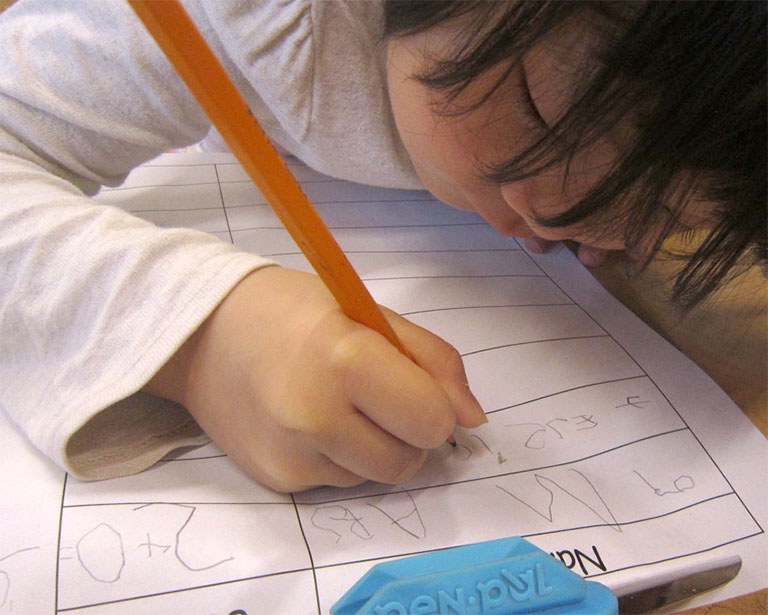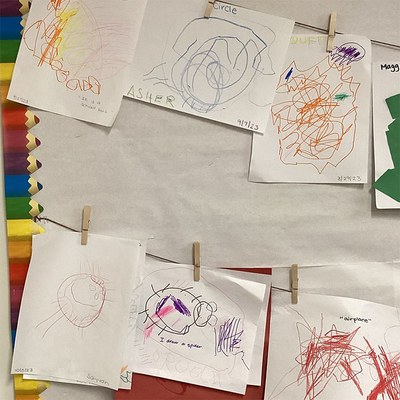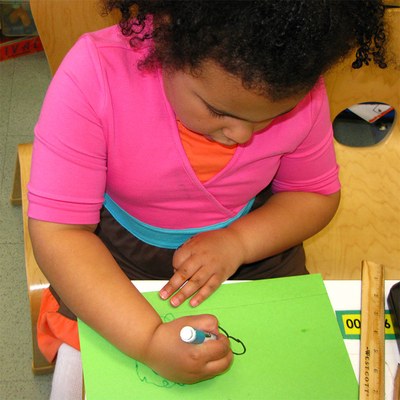How do children learn how to draw and write?

Young child focused on practicing writing their name
It starts with scribbles.
Most young children are naturally interested in drawing and writing. Very young children’s first attempts come from discovering that an action like dragging their finger through food creates a result—it makes a mark! Although probably unplanned and most likely not symbolic, these uncontrolled lines are the beginning stages of scribbling.
Scribbling, characterized by squiggly forms and loopy lines, is a child’s first attempt at early drawing and writing. Although their meaning may not be clear, scribbles are about self-expression and communicating ideas.
From scribbles to figures and letter-like forms
As emerging artists, children’s scribbles morph into drawings that combine shapes and lines to produce more recognizable forms. Picture children’s early illustrations of people, those big circle heads with protruding lines for arms and legs. Children at this developmental stage start to engage in symbolic thinking and understand that the images they create communicate their ideas to others. Scribbles also convey children’s developing understanding of print concepts. Scribbles change from loops and squiggles into repeating patterns of lines and curves called letter-like forms. As emerging writers, children use these letter-like forms to create stories, often highlighting the letters they know best—the ones in their names. Over time, letter strings focus more on the prominent sounds heard in spoken words. This transition shows that a writer is starting to understand the alphabet as a symbol system where letters stand for distinct sounds.
Scribbles also take on directionality, meaning they follow the direction of print. For example, children who learn to write in English understand that print moves across the page from left to right, top to bottom.
Letter-sound knowledge and estimated spelling
You may have heard the term invented spelling used to describe children’s early attempts at spelling using lettersound knowledge. It can look like a word represented by its first letter (d for the word dog) or a cluster of letters that show a word’s most distinctive sounds (prnss for princess). Researchers have shifted away from the term invented spelling, replacing it with estimated spelling. This change aims to show the seriousness of children’s work and promote awareness of the logic guiding children’s efforts in this area (Wright, Cabell, Duke, & Souto-Manning, 2022). Spelling and writing is complex and important work that requires memory, visual perception, fine motor skills, letter-sound awareness, and persistence.
Writing happens in many languages
 Educators can show multiple ways of writing across languages by including words from children’s homes and communities in environmental print and writing activities. For example, an educator might help children learn to recognize and print their names in their school language and the home languages of classmates. This activity can highlight that print directionality and letter shapes sometimes differ by language, but all forms of writing are valuable.
Educators can show multiple ways of writing across languages by including words from children’s homes and communities in environmental print and writing activities. For example, an educator might help children learn to recognize and print their names in their school language and the home languages of classmates. This activity can highlight that print directionality and letter shapes sometimes differ by language, but all forms of writing are valuable.
Drawing and writing skills progress in stages
Educators play an essential role in supporting children in their early efforts at drawing and writing. From scribbling to drawing to writing—each stage supports a child’s developing literacy and communication skills and builds on the steps before.
See the chart below for more details about the developmental progression of drawing and writing:
| Drawing stage | Age range | Observable skills |
|---|---|---|
| Observe others writing and drawing | 3 mos.-1+ years | Watches others and develops ideas of how to make marks with tools; Builds eye-hand coordination and dexterity through play with toys |
| Uncontrolled scribbling | 1.5-2.5 years (ongoing) | Grip shifts to the thumb and pointer finger, allowing for more controlled scribbles; Child uses repeated marks like diagonal, curved, horizontal, or vertical lines and shapes like circles |
| Controlled scribbling | 2-3 years | Child becomes aware that writing uses lines and curves in repeating patterns; Elements of letters appear in drawings |
| Line and patterns | 2.5-3.5 years | Shows symbols, attempts at people and representation, pictures that tell stories, more complexity, great variation in abilities |
| Pictures of objects or people | 3-5 years | Child shows symbolic thinking and tries to represent people, animals, and other objects in drawings; Work is preplanned, and pictures tell stories with increasing detail Letters label parts of drawings |
| Letter and word practice | 3-5 years | Child copies letters or words and begins to use estimated spelling; Recognizes that words come in varied sizes and writing takes on new patterns that resemble sentences |
(Adapted from Zero to Three, 2017)
References
Wright, T. S., Cabell, S. Q., Duke, N. K., & Souto-Manning, M. (2022). Literacy Learning for Infants, Toddlers, and Preschoolers: Key Practices for Educators. Washington DC: National Association for the Education of Young Children.
Zero to Three. (2017, February ). Learning to Write and Draw. Retrieved from Zero to Three: https://www.zerotothree.org/resource/learning-to-write-and-draw/
TIPS 10-4

